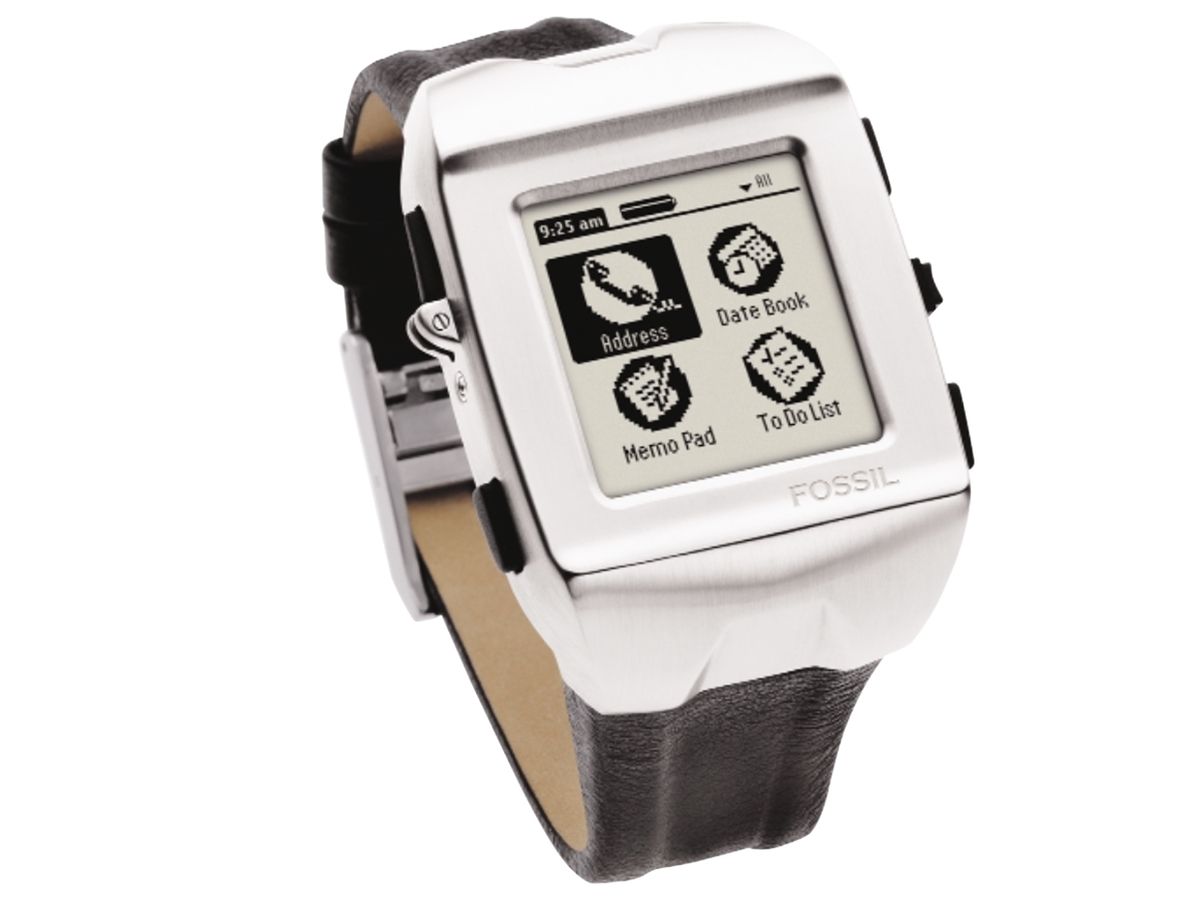Tiny batteries offered only tiny power until recently, so sophisticated electronics in the form of a wristwatch remained in the realm of science fiction. But today it’s possible to put a couple of watthours in a space the size of a postage stamp, enabling a new generation of wearable gadgets.
Here’s what I tried strapping on my wrist this past spring: a PDA, an MP3 player, and a 512-megabyte data bank.
The Wrist PDA with Palm OS, from Fossil Inc., based in Richardson, Texas, is a beauty at US $250. Its screen may measure only 1.4 inches diagonally, but with 160 by 160 pixels, its resolution is the same as that of many full-size PDA screens. With 8 MB of RAM and infrared and USB ports for syncing and charging, this watch is approximately equivalent in capability to a full-size PDA, such as the Palm IIIxe.
Though bigger than the average watch, it is remarkably slim, considering what’s inside. And, like most Fossil products, it’s stylish. With the PDA turned off, the display shows one of 11 watch faces you select, with analog or digital readout choices.
The PDA works just like any Palm, right down to the touch screen and handwriting recognition. But the small size requires some changes to the interface, since there’s no room for the standard application buttons or the touch points printed onto the liquid-crystal display of full-size PDAs. The Fossil PDA replaces these with a nifty three-way rocker switch and several other buttons to navigate through most tasks without need for the stylus. The usual Palm OS address, calendar, notes, and to-do applications are included, and I had no trouble transferring data from my desktop computer into the watch.

The tiny, fold-out stylus is hidden so well in the band’s buckle that I had to read the manual to find it. It’s not for beefy hands, either; imagine writing with a 4-centimeter-long pencil. You have to be careful to keep the watch charged; the battery lasts four days at most, and if it goes dead, you lose any data that you haven’t synced with your desktop computer.
I have only one real issue with this uberwatch: a tiny screen is a tiny screen, and even with larger-than-normal fonts, it’s pretty tough on middle-aged eyes. This product might be what finally spurs me to get those darn reading glasses.
If you’d rather carry a few hours of music instead of your contact list and schedule, check out the MP3 watch from Xonix Electronics Co., Zhu Hai City, China. Xonix makes versions in flash memory sizes from 128 MB ($130) to a full gigabyte ($280) under its own label, as well as for Hewlett-Packard, Microsoft, and others. The watch itself has a quartz-controlled analog movement with no date or alarm function. There is no digital display. Instead, tiny light-emitting diodes embedded in the face indicate the status of the digital music player. A full-size USB connector is hidden in the band; no drivers or special software are required for modern PC and Mac operating systems.
The watch plays MP3 and WMA files and provides five acoustic modes—plain or optimized for jazz, pop, rock, or classical; small earbuds are included. Especially when you work out, you just can’t beat having skip-free music on your wrist, with little to weigh you down. You can use the watch’s flash RAM to store files as well. An optional AC adapter is available for charging, or (as with all of these wrist gadgets) you can charge the watch by plugging it into your computer’s USB port. My favorite feature of the Xonix is the built-in voice recorder that stores hours of notes. The microphone is in the watch, so you can easily capture your dictation as WAV files for playback through the earbuds or transfer to your computer.

The 512-MB Migo watch, $160 from PowerHouse Technologies Group Inc., in San Ramon, Calif., adds a useful new touch to the data storage category. To let you make any Windows PC emulate your own machine, the Migo stores your e-mail, Internet favorites, desktop settings, and more in the watch’s password-secured memory. Connect the watch to a PC and the computer will instantly be reconfigured to replicate your desktop.
Instead of carrying a notebook, you can plug this watch into a hotel’s PC, or even into one in an Internet cafe, and have it become your own. When you disconnect the watch, all traces of your personal information and settings disappear from the PC. You have to install software on your PC to set up the Migo’s replication features—but not on the destination computer. So far, the full Migo functions work only with Windows, but you can also use the watch for simple data storage with a Mac. It popped right up on the desktop of my OS 9 Mac.
Other amazing wristwatch devices coming soon, but not available at press time, include a smaller version of last year’s $200 color wristwatch TV from NHJ Ltd., Tokyo, with the same 1.5-inch diagonal screen and a much longer battery life than the current model, and a two-way Family Radio Service (FRS) radio with an 8-kilometer range, promised soon from Xact Communication LLC, New York City. Samsung Electronics Co., in Suwon, Korea, has shown a cellphone watch prototype for several years now, and I’m still looking forward to that one.
About the Author
Michael Jay Geier has been writing for the technology press for 25 years. From Mar Vista, Calif., he contributes regularly to EE Times, 73 Amateur Radio Today, and Envisioneering.

